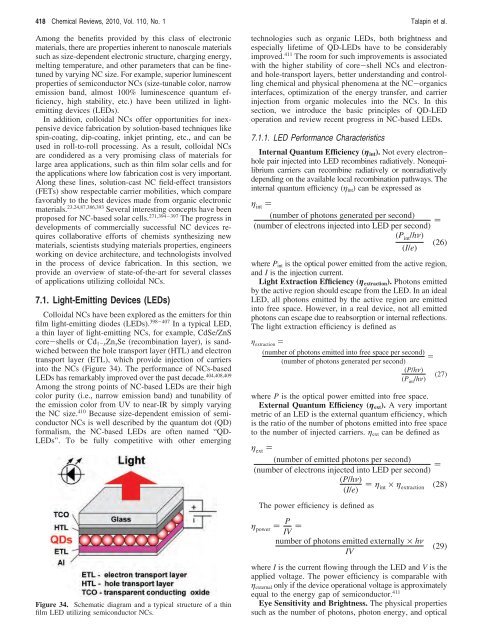Prospects of Colloidal Nanocrystals for Electronic - Computer Science
Prospects of Colloidal Nanocrystals for Electronic - Computer Science
Prospects of Colloidal Nanocrystals for Electronic - Computer Science
You also want an ePaper? Increase the reach of your titles
YUMPU automatically turns print PDFs into web optimized ePapers that Google loves.
418 Chemical Reviews, 2010, Vol. 110, No. 1 Talapin et al.<br />
Among the benefits provided by this class <strong>of</strong> electronic<br />
materials, there are properties inherent to nanoscale materials<br />
such as size-dependent electronic structure, charging energy,<br />
melting temperature, and other parameters that can be finetuned<br />
by varying NC size. For example, superior luminescent<br />
properties <strong>of</strong> semiconductor NCs (size-tunable color, narrow<br />
emission band, almost 100% luminescence quantum efficiency,<br />
high stability, etc.) have been utilized in lightemitting<br />
devices (LEDs).<br />
In addition, colloidal NCs <strong>of</strong>fer opportunities <strong>for</strong> inexpensive<br />
device fabrication by solution-based techniques like<br />
spin-coating, dip-coating, inkjet printing, etc., and can be<br />
used in roll-to-roll processing. As a result, colloidal NCs<br />
are condidered as a very promising class <strong>of</strong> materials <strong>for</strong><br />
large area applications, such as thin film solar cells and <strong>for</strong><br />
the applications where low fabrication cost is very important.<br />
Along these lines, solution-cast NC field-effect transistors<br />
(FETs) show respectable carrier mobilities, which compare<br />
favorably to the best devices made from organic electronic<br />
materials. 23,24,87,386,393 Several interesting concepts have been<br />
proposed <strong>for</strong> NC-based solar cells. 271,394-397 The progress in<br />
developments <strong>of</strong> commercially successful NC devices requires<br />
collaborative ef<strong>for</strong>ts <strong>of</strong> chemists synthesizing new<br />
materials, scientists studying materials properties, engineers<br />
working on device architecture, and technologists involved<br />
in the process <strong>of</strong> device fabrication. In this section, we<br />
provide an overview <strong>of</strong> state-<strong>of</strong>-the-art <strong>for</strong> several classes<br />
<strong>of</strong> applications utilizing colloidal NCs.<br />
7.1. Light-Emitting Devices (LEDs)<br />
<strong>Colloidal</strong> NCs have been explored as the emitters <strong>for</strong> thin<br />
film light-emitting diodes (LEDs). 398-407 In a typical LED,<br />
a thin layer <strong>of</strong> light-emitting NCs, <strong>for</strong> example, CdSe/ZnS<br />
core-shells or Cd1-xZnxSe (recombination layer), is sandwiched<br />
between the hole transport layer (HTL) and electron<br />
transport layer (ETL), which provide injection <strong>of</strong> carriers<br />
into the NCs (Figure 34). The per<strong>for</strong>mance <strong>of</strong> NCs-based<br />
LEDs has remarkably improved over the past decade. 404,408,409<br />
Among the strong points <strong>of</strong> NC-based LEDs are their high<br />
color purity (i.e., narrow emission band) and tunability <strong>of</strong><br />
the emission color from UV to near-IR by simply varying<br />
the NC size. 410 Because size-dependent emission <strong>of</strong> semiconductor<br />
NCs is well described by the quantum dot (QD)<br />
<strong>for</strong>malism, the NC-based LEDs are <strong>of</strong>ten named “QD-<br />
LEDs”. To be fully competitive with other emerging<br />
Figure 34. Schematic diagram and a typical structure <strong>of</strong> a thin<br />
film LED utilizing semiconductor NCs.<br />
technologies such as organic LEDs, both brightness and<br />
especially lifetime <strong>of</strong> QD-LEDs have to be considerably<br />
improved. 411 The room <strong>for</strong> such improvements is associated<br />
with the higher stability <strong>of</strong> core-shell NCs and electronand<br />
hole-transport layers, better understanding and controlling<br />
chemical and physical phenomena at the NC-organics<br />
interfaces, optimization <strong>of</strong> the energy transfer, and carrier<br />
injection from organic molecules into the NCs. In this<br />
section, we introduce the basic principles <strong>of</strong> QD-LED<br />
operation and review recent progress in NC-based LEDs.<br />
7.1.1. LED Per<strong>for</strong>mance Characteristics<br />
Internal Quantum Efficiency (ηint). Not every electron–<br />
hole pair injected into LED recombines radiatively. Nonequilibrium<br />
carriers can recombine radiatively or nonradiatively<br />
depending on the available local recombination pathways. The<br />
internal quantum efficiency (ηint) can be expressed as<br />
ηint )<br />
(number <strong>of</strong> photons generated per second)<br />
(number <strong>of</strong> electrons injected into LED per second) )<br />
(Pint /hν)<br />
(26)<br />
(I/e)<br />
where Pint is the optical power emitted from the active region,<br />
and I is the injection current.<br />
Light Extraction Efficiency (ηextraction). Photons emitted<br />
by the active region should escape from the LED. In an ideal<br />
LED, all photons emitted by the active region are emitted<br />
into free space. However, in a real device, not all emitted<br />
photons can escape due to reabsorption or internal reflections.<br />
The light extraction efficiency is defined as<br />
η extraction )<br />
(number <strong>of</strong> photons emitted into free space per second)<br />
(number <strong>of</strong> photons generated per second)<br />
where P is the optical power emitted into free space.<br />
External Quantum Efficiency (ηext). A very important<br />
metric <strong>of</strong> an LED is the external quantum efficiency, which<br />
is the ratio <strong>of</strong> the number <strong>of</strong> photons emitted into free space<br />
to the number <strong>of</strong> injected carriers. ηext can be defined as<br />
The power efficiency is defined as<br />
(P/hν)<br />
(P int /hν)<br />
where I is the current flowing through the LED and V is the<br />
applied voltage. The power efficiency is comparable with<br />
ηexternal only if the device operational voltage is approximately<br />
equal to the energy gap <strong>of</strong> semiconductor. 411<br />
Eye Sensitivity and Brightness. The physical properties<br />
such as the number <strong>of</strong> photons, photon energy, and optical<br />
)<br />
(27)<br />
η ext )<br />
(number <strong>of</strong> emitted photons per second)<br />
(number <strong>of</strong> electrons injected into LED per second) )<br />
(P/hν)<br />
(I/e) ) η int × η extraction (28)<br />
η power ) P<br />
IV )<br />
number <strong>of</strong> photons emitted externally × hν<br />
IV<br />
(29)
















